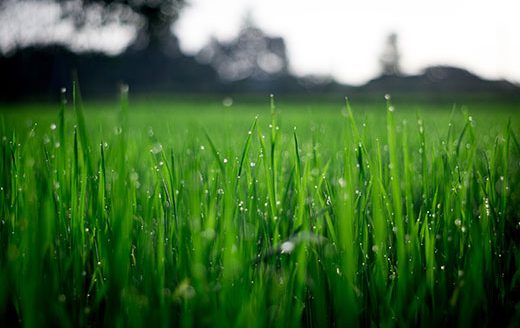Newer grass varieties can help boost cool-season lawns this Fall

K-State horticulture expert shares tips on what to look for when purchasing seed
As summer’s heat cools into fall, homeowners have an opportunity to refresh their home lawns. And Kansas State University horticulture expert Cynthia Domenghini says there are some good choices for over-seeding or replacing cool season grasses.
The most popular cool-season grass in Kansas has been a tall fescue variety known as K-31, but even that old standby is giving way to higher-quality choices.
“There are a myriad number of newer varieties with improved color, density and finer leaf texture,” Domenghini said. “Most of these newer varieties are very close to one another in quality. We recommend a regional blend of tall fescue cultivars that are commonly available in local garden centers and hardware stores.”
Domenghini said varieties more commonly sold in big box stores often don’t perform well in Kansas because they often contain cultivars that don’t tolerate the state’s stressful weather conditions.
To pick a reliable cultivar, Domenghini advises paying attention to the percentage of ‘Crop Seed’ and ‘Weed Seed’ listed on the label. “Anything over 0.01% of either of these is not recommended” for Kansas lawns,” Domenghini said.
“Though K-31 may still be a good choice for large, open areas where weeds and a lighter green color can be tolerated, the newer cultivars will give better performance for those who desire a high-quality turf,” she said.
Domenghini added that Kentucky bluegrass is becoming a more common choice for home lawns. Kentucky bluegrass is not as heat and drought tolerate as tall fescue and warm-season grasses, but is reliable in areas like northeast Kansas where there is sufficient annual rainfall.
“It is also grown under irrigation in northwest Kansas where the higher elevation allows for cooler summer night temperatures,” Domenghini said.
K-State Research has published a list of the highest rated Kentucky bluegrass cultivars for Kansas. That publication breaks down more than two dozen cultivars for high-quality lawns where visual appearance is the prime concern; and ten others for low maintenance and limited watering.
Domenghini said high maintenance lawns are those that receive irrigation to prevent stress and receive at least three applications of fertilizer per year. Lawns under a low-maintenance program receive limited watering and fertilization, typically 1-2 pounds of nitrogen per square feet per year.
“Obviously a low-input lawn will not be as attractive as a higher input lawn, but you can expect the recommended cultivars to look fairly good in the spring and fall, while going dormant in the summer,” Domenghini said.
Domenghini and her colleagues in K-State’s Department of Horticulture and Natural Resources produce a weekly Horticulture Newsletter with tips for maintaining home landscapes and gardens.
Interested persons can subscribe to the newsletter, as well as send their garden and yard-related questions to Domenghini at [email protected], or contact your local K-State Research and Extension office.


